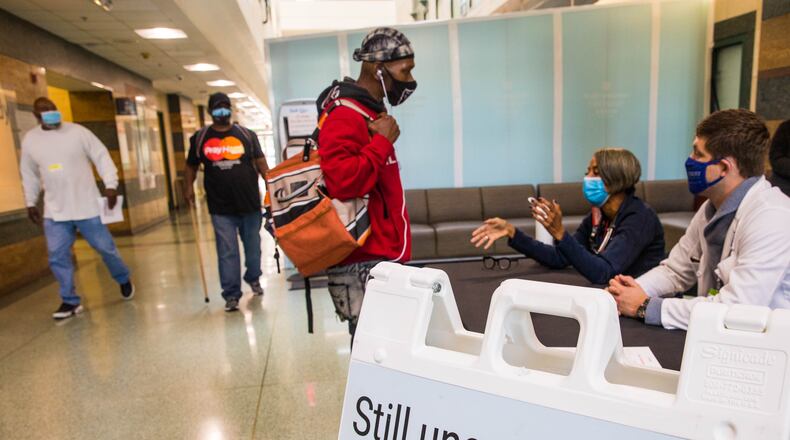Georgia continued its downward trajectory from the peak of the delta wave as the number of new infections and people hospitalized for COVID-19 hit their lowest points since late July.
On Friday, the seven-day rolling average for new confirmed and suspected infections was 1,638, down more than 80% from the late August peak, Georgia Department of Public Health data shows. The state reported 1,562 people currently hospitalized for the disease as of about noon Friday. The number of people hospitalized for COVID-19 peaked during the delta wave in early September at more than 6,000.
For the seven days that ended Wednesday, Georgia tied for the eighth-lowest case rate among the 50 states, Washington, D.C., and Puerto Rico, according to federal data.
Credit: HYOSUB SHIN / AJC
Credit: HYOSUB SHIN / AJC
Georgia remains in the red zone for rate of new cases in that time of just greater than 100 per 100,000 people. The highest case rates nationally in that time were generally located in northern states such as Alaska, Montana, Wyoming, Idaho and North Dakota.
Deaths, which are a lagging indicator of the disease and take time to be reported, remain elevated in Georgia.
On Friday, the state reported 121 new confirmed deaths. Georgia ranked sixth worst nationally in the rate of death for the seven days ending Wednesday.
Georgia continues to lag with vaccination rates. DPH reports that 49% of Georgians are fully vaccinated for COVID-19, which remains near the bottom of the nation.
Here’s a look at major developments related to COVID-19 over the past week
Boosters and mix match of vaccines OK’d
More Georgians can get a COVID-19 booster and they can opt for a different company’s vaccine for that next shot, federal health officials said Thursday.
Certain people who received Pfizer vaccinations months ago already were eligible for a booster, and now the Centers for Disease Control and Prevention says specific Moderna and Johnson & Johnson recipients qualify, too. And in a bigger change, the agency is allowing the flexibility of “mixing and matching” that extra dose regardless of which type people received first.
There still are restrictions on who qualifies and when for a booster. Starting six months past their last Pfizer or Moderna vaccination, people are urged to get a booster if they’re 65 or older, nursing home residents, or at least 50 and at increased risk of severe disease because of health problems. Boosters also were allowed, but not urged, for adults of any age at increased risk of infection because of health problems or their jobs or living conditions. That includes health care workers, teachers and people in jails or homeless shelters.
Credit: Alyssa Pointer
Credit: Alyssa Pointer
When it comes to single-shot J&J vaccine, a COVID-19 booster is recommended for adults at least two months after their vaccination. In Georgia, only about 265,000 people or about 5% of the total people vaccinated received a J&J shot.
The CDC panel didn’t explicitly recommend anyone get a different brand than they started with but left open the option — saying only that a booster of some sort was recommended. And some of the advisers said they would prefer that J&J recipients receive a competitor’s booster, citing preliminary data from an ongoing government study that suggested a bigger boost in virus-fighting antibodies from that combination.
The booster vaccine doses are widely available at pharmacies, doctor’s offices and vaccination sites, according to the Georgia Department of Public Health.
TSA works to increase employee vaccination rate ahead of mandate
With next month’s deadline quickly approaching, the Transportation Security Administration is racing to get more of its employees vaccinated against COVID-19 as required by a federal mandate.
Last month, President Joe Biden issued an executive order that requires federal employees to get fully vaccinated by Nov. 22.
In the order, Biden said he was doing so to ensure “the health and safety of the Federal workforce and the efficiency of the civil service.”
About 60% of the TSA’s workforce has been vaccinated, “and that number needs to go quite a bit higher over the next few weeks,” TSA Administrator David Pekoske told CNN in an interview last week.
But a TSA spokesman said Monday that the agency doesn’t have information on the vaccination status of its employees. Thus, the figure is likely not an accurate reflection of the actual vaccination rate, he said.
Credit: JOHN SPINK / AJC
Credit: JOHN SPINK / AJC
To meet the president’s deadline, employees needed to have the first dose of the Moderna vaccine by Oct. 11 and the first dose of the Pfizer vaccine by Monday. That’s because of the wait between the shots, as well the time it takes to build immunity after the second injection.
Otherwise, to comply with the order, federal workers must get the single-dose Johnson & Johnson vaccine by Nov. 8.
It’s yet to be seen how a shortfall could affect lines and wait times at Hartsfield-Jackson International, one of the world’s busiest airports.
TSA said it does not have a breakdown of vaccination rates at individual airports.
The agency said it is hosting employee town halls, sending emails and posting information on the requirements in break rooms.
Staff writer Kelly Yamanouchi and The Associated Press contributed to this report.
Keep Reading
The Latest
Featured







